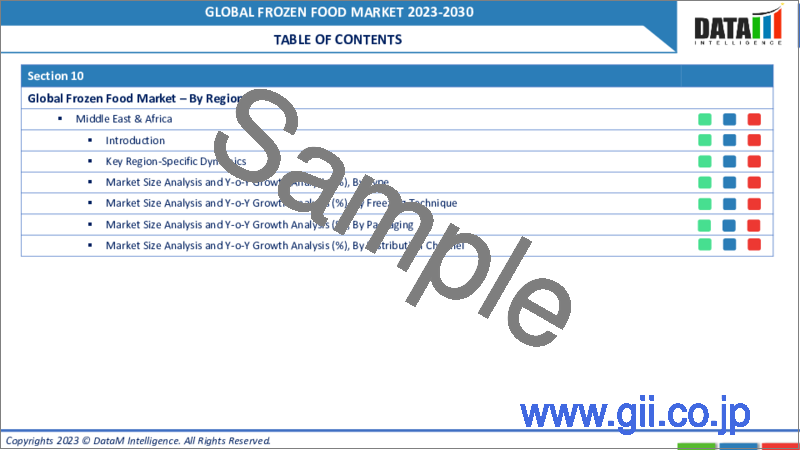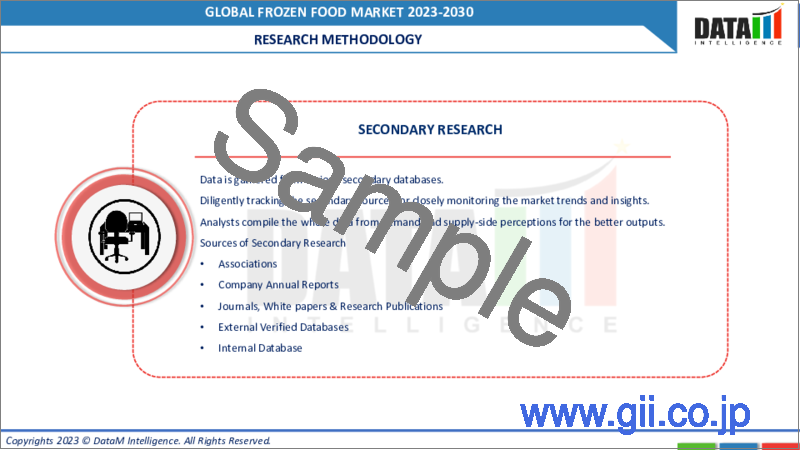|
|
市場調査レポート
商品コード
1325330
冷凍食品の世界市場-2023年~2030年Global Frozen Food Market - 2023-2030 |
||||||
カスタマイズ可能
適宜更新あり
|
|||||||
| 冷凍食品の世界市場-2023年~2030年 |
|
出版日: 2023年08月04日
発行: DataM Intelligence
ページ情報: 英文 165 Pages
納期: 即日から翌営業日
|
- 全表示
- 概要
- 目次
市場概要
世界の冷凍食品市場は2022年に301億米ドルに達し、2023年から2030年の予測期間中にCAGR 5.7%で成長し、2030年には468億米ドルに達すると予測されています。冷凍スナックや冷凍インスタント食品の需要の増加が、世界の冷凍食品市場の成長を牽引しています。
世界中で様々な製品の発売や買収が冷凍食品市場の成長を後押ししています。例えば、2023年5月、インドのスナック・加工食品メーカーBikano社は、国際市場のセイボリースナック、スイーツ、冷凍品など幅広い冷凍製品の発売を発表しました。冷凍ピザ、デザート、各種冷凍果物・野菜など、様々な冷凍スナックの入手可能性が市場を拡大しています。
小売環境の開拓、インスタント食品の需要増加、コールドチェーン市場の技術進歩が市場の主な促進要因となっています。加えて、雇用人口の増加、ライフスタイルの変化、レディミールや即席食品に対する需要の増加が冷凍食品市場を牽引しています。
市場力学
雇用人口比率の増加が世界の冷凍食品市場の成長を牽引しています。
雇用人口比率の増加は冷凍食品市場の成長にプラスの影響を与えます。例えば、米国の2023年5月の雇用人口比率は約60.30%です。2022年には、ドイツでは男性の約80.6%、女性の約73.1%が雇用されています。雇用人口の増加は、その利便性から市場の成長に直接影響します。
働く女性の人口が多様化したことで、彼女たちが料理をする機会はほとんどなくなっています。米国の2022年時点の女性就業率は約54.7%です。中国の2022年の女性労働力率は約61.07%です。冷凍食品は食事の準備に時間がかからず、量も少ないため、働く女性に利便性を提供し、市場拡大の原動力となっています。
新製品の発売が冷凍食品市場の成長を牽引。
市場の主要企業が革新的な新製品を発売することが、市場成長の原動力となっています。メーカーは消費者の要求、嗜好の変化に注目し、冷凍肉、冷凍魚介類などの新製品を市場に投入しています。例えば、2022年4月、インドの大手チルド食肉・冷凍食品ブランドであるPrasuma社は、顧客を魅了し続けるために、冷凍食品ポートフォリオの新製品を発売しました。
いくつかの新しい食品加工工場の設立は、市場のより大幅な拡大を証明しています。例えば、2022年4月、ブラジルの食肉加工企業であるJBS S.A.は、中東での事業拡大のため、サウジアラビアとアラブ首長国連邦に、主に冷凍食品を生産する2つの加工食品工場を新設しました。
冷凍食品に関する健康上の懸念が市場成長を抑制します。
冷凍食品はさまざまな温度で保存されるため、栄養分が失われる可能性が高くなります。冷凍食品は一定の低温で保存されるため、ビタミンCや葉酸などの栄養素が失われる傾向があります。冷凍食品の栄養価が生鮮食品や自然食品と異なることが、市場の成長を妨げています。健康的な食習慣の増加と生鮮食品への需要の高まりが市場拡大を抑制しています。
冷凍食品は多くの加工工程を経ます。食品を大量に加工することで、血圧上昇、糖尿病、心臓病などの病気を引き起こす可能性があります。さらに、解凍された肉の微生物汚染は食中毒を引き起こす可能性があります。インフラの不足と食品安全への懸念が、冷凍食品市場の成長を妨げています。
COVID-19影響分析
COVID-19分析には、COVID前シナリオ、COVIDシナリオ、COVID後シナリオが含まれ、価格力学(COVID前シナリオと比較したパンデミック中およびパンデミック後の価格変動を含む)、需給スペクトラム(取引制限、封鎖、およびその後の問題による需要と供給のシフト)、政府の取り組み(政府機関による市場、セクター、産業を復興させる取り組み)、メーカーの戦略的取り組み(COVID問題を緩和するためにメーカーが行ったことをここで取り上げる)が含まれます。
目次
第1章 調査手法と調査範囲
第2章 市場の定義と概要
第3章 エグゼクティブサマリー
第4章 市場力学
- 市場への影響要因
- 促進要因
- 抑制要因
- 機会
- 影響分析
第5章 産業分析
- ポーターのファイブフォース分析
- サプライチェーン分析
- 価格分析
- 規制分析
第6章 COVID-19分析
第7章 製品タイプ別
- 食肉・家禽
- 魚介類
- 果物・野菜
- デザート
- その他
第8章 地域別
- 北米
- 米国
- カナダ
- メキシコ
- 欧州
- ドイツ
- 英国
- フランス
- イタリア
- スペイン
- その他欧州
- 南米
- ブラジル
- アルゼンチン
- その他南米
- アジア太平洋
- 中国
- インド
- 日本
- オーストラリア
- その他アジア太平洋地域
- 中東・アフリカ
第9章 競合情勢
- 競合シナリオ
- 市況/シェア分析
- M&A分析
第10章 企業プロファイル
- Nestle
- 企業概要
- 製品ポートフォリオと説明
- 財務概要
- 主な動向
- Tyson Foods
- ConAgra Foods
- Unilever
- Pinnacle
- Kraft Heinz
- General Mills
- Schwan's
- Kellogg's
- Grupo Bimbo S.A.B. de C.V.
第11章 付録
Market Overview
Global Frozen Food Market reached US$ 30.1 billion in 2022 and is expected to reach US$ 46.8 billion by 2030 growing with a CAGR of 5.7% during the forecast period 2023-2030. The increasing demand for frozen snacks and frozen convenience food is driving the global frozen food market growth.
The various product launches and acquisitions worldwide are boosting the frozen food market growth. For instance, in May 2023, Bikano, India's snack and packaged food manufacturing company, announced the launch of frozen products in the international market wide range of savoury snacks, sweets, and frozen items. The availability of various frozen snacks, such as frozen pizza, desserts, and various frozen fruits and vegetables, is expanding the market.
The development in the retail landscape, increasing demand for convenience food and technological advancement in the cold chain market are major driving factors for the market. In addition, the high employment population, changing lifestyles, and increasing demand for ready-to-cook or ready-to-eat food drive the frozen food market.
Market Dynamics
The Growing Employment-Population Ratio is Driving the Global Frozen Food Market Growth.
The increase in the employment-population ratio positively influences the frozen food market growth. For instance, US employment-population ratio is about 60.30 % for May 2023. In 2022, Germany had around 80.6 percent of men and 73.1 percent of women employed. The increase in employment-population directly affects market growth due to its convenience.
The diverse increase in the working female population is left them with very little for cooking. The female employment in United States, as of 2022, was about 54.7 %. The female labor force participation rate in China was around 61.07 % in 2022. The frozen meals take less time and little amount to prepare meals, providing convenience to working women and driving market expansion.
New Product Launches Drive the Frozen Food Market Growth.
Launching new and innovative products from the key players in the market is driving market growth. The manufacturers are focussing on consumer requirements, changing preferences, and releasing new products like frozen meat, and frozen seafood into the market. For instance, in April 2022, Prasuma, India's leading chilled meat and frozen food brand, launched new products in its frozen food portfolio in a bid to continue captivating its customers.
Establishing several new food processing plants is proving the more significant expansion of the market. For instance, in April 2022, JBS S.A., a Brazilian meat processing enterprise, brought two new processed food plants in Saudi Arabia and the United Arab Emirates that mainly produce frozen food to expand its business in the Middle East.
The Health Concerns Related to Frozen Food Restrains the Market Growth.
There is an increased chance of nutrient loss in frozen food materials as they are stored at varying temperatures. Frozen foods are stored at a constant low temperature and tend to lose nutrients like vit C and folate. The difference in the nutritional values of frozen food to that of fresh and natural food is hindering market growth. The increasing healthy food habits and growing demand for fresh food restrain market expansion.
Frozen food undergoes many processing procedures. The heavy processing of the food may cause diseases, including increased blood pressure, diabetes, heart disease, and other health concerns. Furthermore, microbial contamination of defrosted meat can lead to food poisoning. The lack of infrastructure and food safety concerns is hindering the frozen food market growth.
COVID-19 Impact Analysis
The COVID-19 Analysis includes Pre-COVID Scenario, COVID Scenario and Post-COVID Scenario along with Pricing Dynamics (Including pricing change during and post-pandemic comparing it with pre-COVID scenarios), Demand-Supply Spectrum (Shift in demand and supply owing to trading restrictions, lockdown, and subsequent issues), Government Initiatives (Initiatives to revive market, sector or Industry by Government Bodies) and Manufacturers Strategic Initiatives (What manufacturers did to mitigate the COVID issues will be covered here).
Segment Analysis
The global frozen food market is segmented based on product type, and region.
In the Global Frozen Food Market, the Dessert Segment Holds the Largest Market Share.
The global frozen food market has been segmented by product type into meat & poultry, fish/seafood, fruits and vegetables, desserts, and others. The dessert products segment held the largest frozen food market share of 38.8% in 2022 in the frozen food market analysis report. The increasing demand for frozen convenience food and frozen desserts is raising the expansion of the segment's market growth.
The cool and refreshing nature of the frozen deserts is always people's favourite. The delicious taste and availability of various types & flavors of frozen desserts fuel the segment's growth. The new and premium product launches, such as vegan ice creams, are boosting the segment's growth. For instance, in 2022, Ben & Jerry's, an American manufacturer of ice cream, frozen yogurt, and sorbet, launched two plant-based ice cream flavors, including, chocolate milk & cookies and dirt cake.
Geographical Analysis
The North America Region Held the Largest Frozen Food Market Share.
The global frozen food market is segmented into five parts based on geography: North America, South America, Europe, Asia-Pacific, the Middle East, and Africa. The North American frozen food market held the largest market share of 38.6% in 2022 in the frozen food market analysis. The rising demand for convenient and ready-to-eat foods is driving market growth in this region.
The increasing product launches in this region are driving market growth. For instance, In April 2023, JBS S.A., through its brand Seara, announced to launch of ten innovative frozen breaded poultry products in order to expand its portfolio of breaded chicken products in Brazil and satisfy its customers through its expansion. In addition, the rising disposable income and hectic lifestyle are increasing the market growth in this region.
Competitive Landscape
The major global players in the market include Nestle, Tyson Foods, ConAgra Foods, Unilever, Pinnacle, Kraft Heinz, General Mills, Schwan's, Kellogg's, and Grupo Bimbo S.A.B. de C.V.
Global Recession/Ukraine-Russia War/COVID-19, and Artificial Intelligence Impact Analysis:
COVID-19 Impact:
The unprecedented COVID-19 pandemic in 2020 profoundly affected the food industry. COVID-19 has considerably impacted the global food supply chain phases involving frozen food production, processing, distribution, and consumption due to lockdowns and restrictions imposed by various governments.
Everything has changed due to the COVID-19 epidemic. It has influenced practically every industry, whether positively or negatively. The COVID-19 pandemic's effects on world economic conditions have had an influence. They could impact interest rates, foreign exchange rates, commodities and energy prices, and the efficient operation of financial and capital markets.
The COVID-19 pandemic issue has had an impact on the food industry as well. The COVID-19 pandemic is upending life, and the food sector is seeing increased trends like frozen food. The food businesses are launching innovative programs, including frozen food, that are straightforward to utilize.
Why Purchase the Report?
- To visualize the global frozen food market segmentation based on product type, and region and understand key commercial assets and players.
- Identify commercial opportunities in the market by analyzing trends and co-development.
- Excel data sheet with numerous data points of frozen food market-level with all segments.
- The PDF report includes a comprehensive market analysis after exhaustive qualitative interviews and an in-depth market study.
- Product mapping is available as Excel consists of key products of all the major market players.
The Global Frozen Food Market report would provide approximately 45 tables, 40 figures and 165 Pages.
Target Audience 2023
- Manufacturers/ Buyers
- Industry Investors/Investment Bankers
- Research Professionals
- Emerging Companies
Table of Contents
1. Methodology and Scope
- 1.1. Research Methodology
- 1.2. Research Objective and Scope of the Report
2. Market Definition and Overview
3. Executive Summary
- 3.1. Market Snippet, by Product Type
- 3.2. Market Snippet, by Region
4. Market Dynamics
- 4.1. Market Impacting Factors
- 4.1.1. Drivers
- 4.1.2. Restraints
- 4.1.3. Opportunity
- 4.1.4. Impact Analysis
5. Industry Analysis
- 5.1. Porter's Five Force Analysis
- 5.2. Supply Chain Analysis
- 5.3. Pricing Analysis
- 5.4. Regulatory Analysis
6. COVID-19 Analysis
- 6.1. Analysis of COVID-19
- 6.1.1. Scenario Before COVID
- 6.1.2. Scenario During COVID
- 6.1.3. Scenario Post COVID
- 6.2. Pricing Dynamics Amid COVID-19
- 6.3. Demand-Supply Spectrum
- 6.4. Government Initiatives Related to the Market During the Pandemic
- 6.5. Manufacturers Strategic Initiatives
- 6.6. Conclusion
7. By Product Type
- 7.1. Introduction
- 7.1.1. Market Size Analysis and Y-o-Y Growth Analysis (%), By Product Type
- 7.1.2. Market Attractiveness Index, By Product Type
- 7.2. Meat & Poultry
- 7.2.1. Introduction
- 7.2.2. Market Size Analysis and Y-o-Y Growth Analysis (%)
- 7.3. Fish / Seafood
- 7.4. Fruits and Vegetables
- 7.5. Desserts
- 7.6. Others
8. By Region
- 8.1. Introduction
- 8.1.1. Market Size Analysis and Y-o-Y Growth Analysis (%), By Region
- 8.1.2. Market Attractiveness Index, By Region
- 8.2. North America
- 8.2.1. Introduction
- 8.2.2. Key Region-Specific Dynamics
- 8.2.3. Market Size Analysis and Y-o-Y Growth Analysis (%), By Product Type
- 8.2.4. Market Size Analysis and Y-o-Y Growth Analysis (%), By Country
- 8.2.4.1. U.S.
- 8.2.4.2. Canada
- 8.2.4.3. Mexico
- 8.3. Europe
- 8.3.1. Introduction
- 8.3.2. Key Region-Specific Dynamics
- 8.3.3. Market Size Analysis and Y-o-Y Growth Analysis (%), By Product Type
- 8.3.4. Market Size Analysis and Y-o-Y Growth Analysis (%), By Country
- 8.3.4.1. Germany
- 8.3.4.2. U.K.
- 8.3.4.3. France
- 8.3.4.4. Italy
- 8.3.4.5. Spain
- 8.3.4.6. Rest of Europe
- 8.4. South America
- 8.4.1. Introduction
- 8.4.2. Key Region-Specific Dynamics
- 8.4.3. Market Size Analysis and Y-o-Y Growth Analysis (%), By Product Type
- 8.4.4. Market Size Analysis and Y-o-Y Growth Analysis (%), By Country
- 8.4.4.1. Brazil
- 8.4.4.2. Argentina
- 8.4.4.3. Rest of South America
- 8.5. Asia-Pacific
- 8.5.1. Introduction
- 8.5.2. Key Region-Specific Dynamics
- 8.5.3. Market Size Analysis and Y-o-Y Growth Analysis (%), By Product Type
- 8.5.4. Market Size Analysis and Y-o-Y Growth Analysis (%), By Country
- 8.5.4.1. China
- 8.5.4.2. India
- 8.5.4.3. Japan
- 8.5.4.4. Australia
- 8.5.4.5. Rest of Asia-Pacific
- 8.6. Middle East and Africa
- 8.6.1. Introduction
- 8.6.2. Key Region-Specific Dynamics
- 8.6.3. Market Size Analysis and Y-o-Y Growth Analysis (%), By Product Type
9. Competitive Landscape
- 9.1. Competitive Scenario
- 9.2. Market Positioning/Share Analysis
- 9.3. Mergers and Acquisitions Analysis
10. Company Profiles
- 10.1. Nestle*
- 10.1.1. Company Overview
- 10.1.2. Product Portfolio and Description
- 10.1.3. Financial Overview
- 10.1.4. Key Developments
- 10.2. Tyson Foods
- 10.3. ConAgra Foods
- 10.4. Unilever
- 10.5. Pinnacle
- 10.6. Kraft Heinz
- 10.7. General Mills
- 10.8. Schwan's
- 10.9. Kellogg's
- 10.10. Grupo Bimbo S.A.B. de C.V.
LIST NOT EXHAUSTIVE
11. Appendix
- 11.1. About Us and Services
- 11.2. Contact Us






